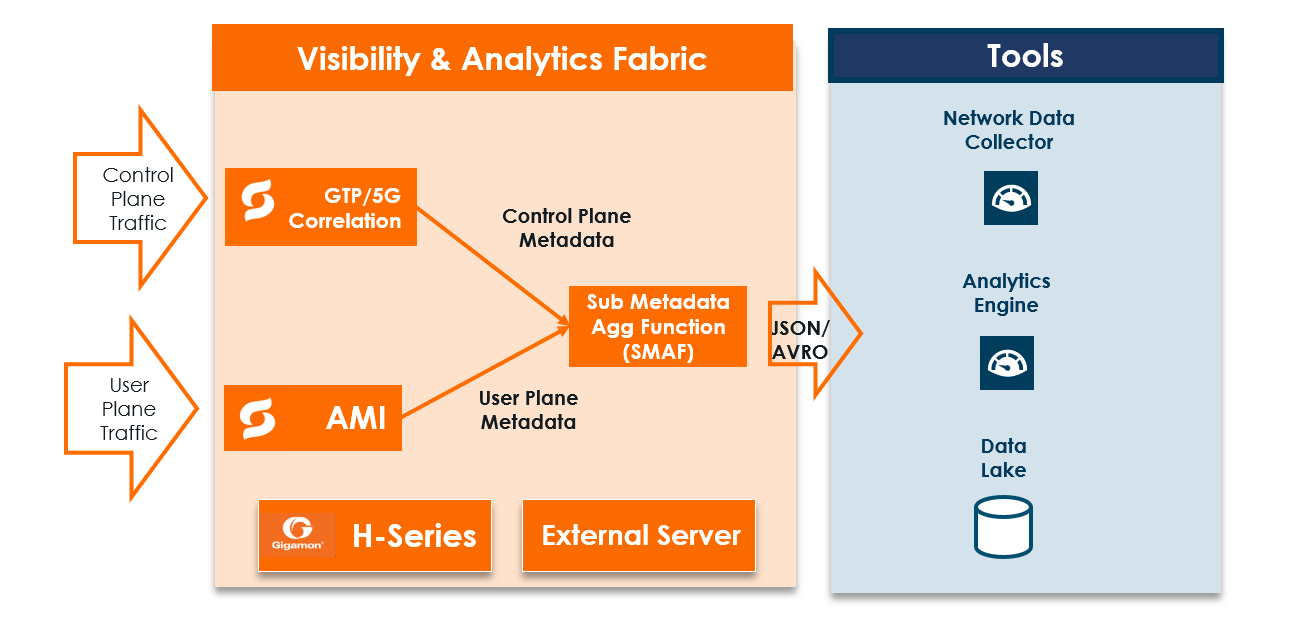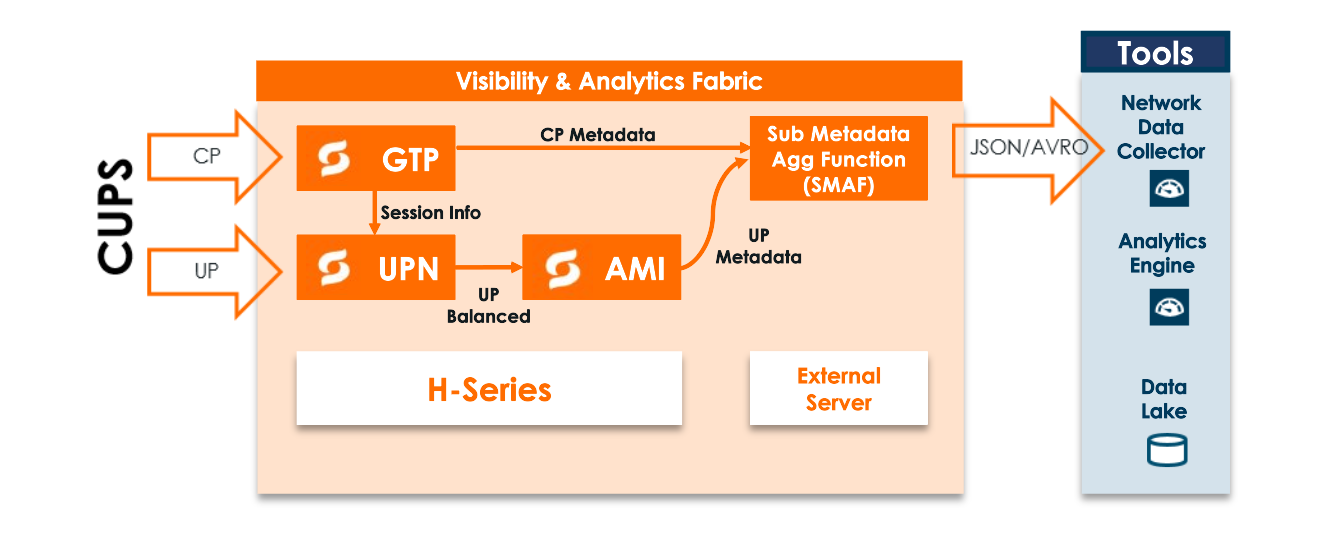Subscriber-Aware Metadata (BETA)
Required License: Subscriber-Aware Metadata, Subscriber Metadata Aggregation Function
This section provides the following information about the Subscriber-Aware Metadata feature (BETA):
Overview
The Subscriber-Aware Metadata (SAM) feature produces datasets on subscriber-level network activity that is useful for analytics. This data is created across a set of high-value dimensions in terms of:
- Subscriber session
- Over-the-Top (OTT) application
- Handset type
- Location (cell)
- Service QCI/QoS
Note: Early Access is a pre-GA feature status indicating it is not recommended for production networks. The functionality has been tested. Little to no system testing has been performed, however, and performance/scale data is not yet available. Preliminary documentation is available.
How SAM Works
The metadata of subscriber activities is extracted using GTP or 5G correlation and Application Metadata Intelligence (AMI) modules of the Gigamon’s Network Visibility nodes. After extraction, the following information is correlated and merged by Sub-Metadata Aggregator Function (SMAF) server and exported to the Data Collection Center in JSON or AVRO format:
- Extracted metadata information
- Transaction event records
- Application Metadata Intelligence flow records

The exporter sends the final SAM records to the destination using file transfer or KAFKA bus. The file records are stored in a system for a period that is configured to store the data. In case of filer transfer failures, the file transfer attempts occur for the number of times the attempts are configured . The following table provides the information about the exporter type and the supported format for SFTP and KAFKA:
|
|||||||||||||||||||
|---|---|---|---|---|---|---|---|---|---|---|---|---|---|---|---|---|---|---|---|
| Local |
|
||||||||||||||||||
| SFTP |
|
||||||||||||||||||
|
|
Message Format |
||||||||||||||||||
| KAFKA |
|
||||||||||||||||||
* Reduces Server performance
GigaVUE-FM is the centralized configuration manager for SAM, which is deployed across multiple nodes in a network. SAM is supported in:
In each case, SAM is supported in both no-engine and engine-grouping models.
Control and User Plane Separation (CUPS) solution
In CUPS solution, SAM feature is supported in:
- No engine grouping model
- Engine grouping model
In no engine grouping model, there are two types of processing modules:
- Control Plane Network (CPN) engine
- Application Metadata Intelligence engine (AMI)-generates metadata for user plane traffic including throughput and other Key Performance Indicators (KPIs). It also performs optional OTT classification.
No-engine grouping is intended for scenarios where an entire gateway (e.g.SGW, UPF) can be processed by a single AMI engine. If traffic utilization exceeds the capacity of a single AMI engine, then engine grouping is required.
Transaction Event Records are generated by CPN and sent to the Subscriber Metadata Aggregation Function (SMAF). SMAF runs on an external server or VM.
In engine grouping model, there are three types of processing modules:
| Control Plane Network (CPN) engine |
| User Plane Network (UPN) engine |
| Application Metadata Intelligence (AMI) engine |
In engine grouping model, multiple UPN GigaSMART engines are grouped together for processing user plane traffic to achieve a scalable solution.
The user plane traffic first passes through the UPN(s) and then passes AMI engines, in order to be balanced by subscriber to each of the AMI engines. AMI engines are not natively subscriber aware.
GTP-u packets are load-balanced to AMI module by UPN processing engines based on the Subscriber IDs.
Note: In engine grouping model, hybrid ports should be used to chain the traffic from GTP engine or UPN engine to AMI engines. In CPN, engine grouping is not supported.
The diagram shows the Subscriber-Aware Metadata and their engine components in the engine grouping model for CUPS solution.

Non-CUPS solution
In Non-CUPS solution, SAM feature is supported in:
- No engine grouping model
- Engine grouping model
In no engine grouping model, there are two types of processing engines:
- GTP Correlation —GTP control and user plane traffic from various network elements is sent to the GTP-Correlation GigaSMART engine. GTP transaction level events are generated and the information is sent to SMAF server.
- Application Metadata Intelligence (AMI) engine — Generates metadata for user plane traffic including throughput and other KPIs. It also performs optional OTT classification.
In engine grouping model, there are two types of processing module.
- GTP Correlation— GTP control and user plane traffic from various network elements is sent to the GTP Correlation GigaSMART engine. GTP transaction level events are generated and the information is sent to the SMAF server.
- Application Metadata Intelligence engine — Generates metadata for user plane traffic including throughput and other KPIs.
- GTP User Plane traffic— GTP User Plane traffic is consumed by GTP GigaSMART modules, which are non-leaders. The GTP user plane traffic are load balanced among engines based on Outer-IP-Header of GTP-U packets. GTP-U packets are load balanced to AMI module based on the Subscription IDs. I
In engine grouping model, multiple GTP GigaSMART engines are grouped together for processing of user plane traffic to achieve a scalable solution.
The diagram shows the Subscriber-Aware Metadata and their engine components in Non-CUPS solution.

Licensing
| SMT-HC2-SAM —The SMT-HC2-SAM card has GigaSMART, GigaVUE-HC2, Subscriber-Aware Metadata license for the AMI engine component. It also includes entitlement to unlimited use of Subscriber Metadata Aggregation Function (SMAF), but does not include SMAF hardware. Also, does not include GTP and/or 5G Correlation license. |
| SMT-HC3-SAM—The SMT-HC3-SAM card has GigaSMART, GigaVUE-HC3 Subscriber-Aware Metadata license for the AMI engine component. It also includes entitlement to unlimited use of Subscriber Metadata Aggregation Function (SMAF), but does not include SMAF hardware. Also, does not include GTP and/or 5G Correlation license. |
Configuration of SAM
To configure Subscriber-Aware Metadata (SAM) , refer to Configuration of Subscriber-Aware Metadata using Ansible.



